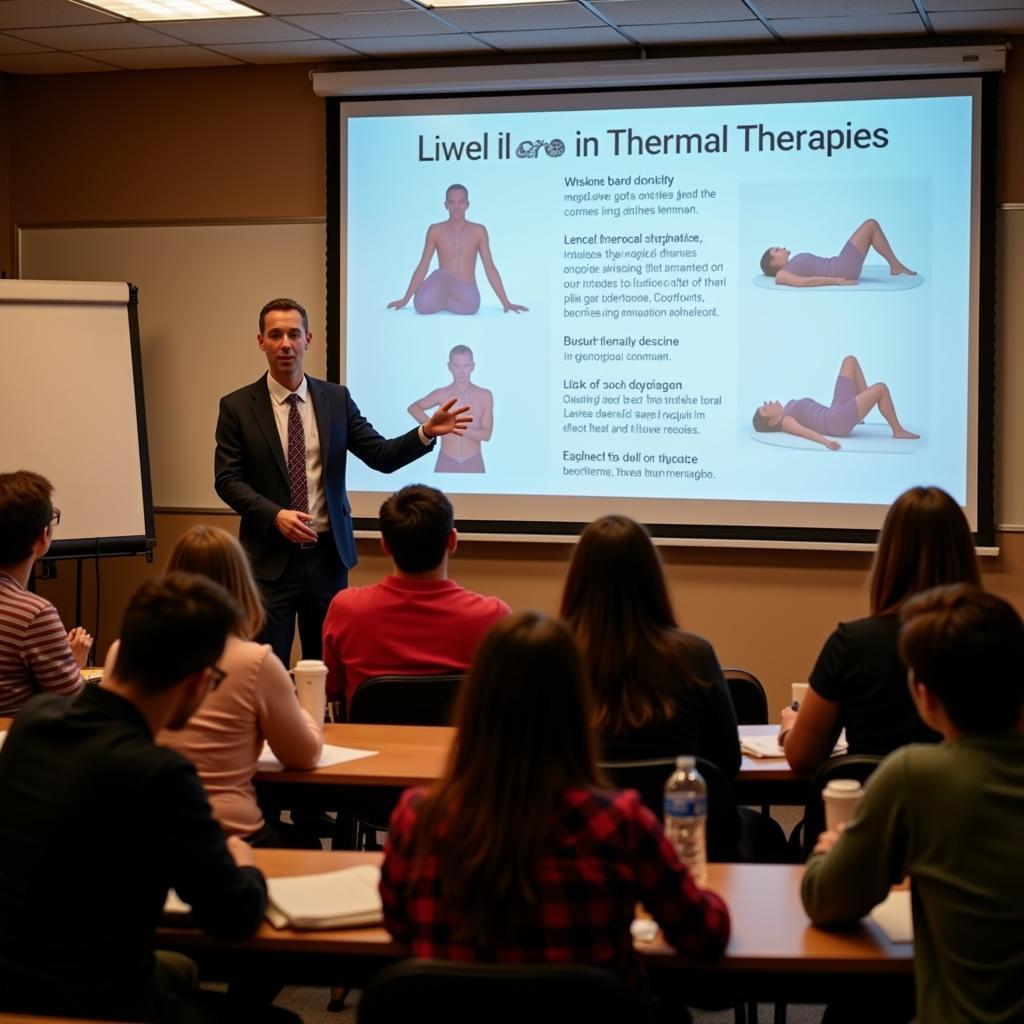The concept of a “Society Of Thermal Medicine” might initially seem perplexing. After all, when we think of societal structures, images of governments, economies, and cultural norms often come to mind. However, delving deeper reveals a fascinating intersection between the therapeutic applications of heat, social well-being, and the potential for a collective approach to health and healing. This exploration delves into the exciting possibilities that a society focused on thermal medicine might offer.
 Conceptual Image of a Society Embracing Thermal Medicine
Conceptual Image of a Society Embracing Thermal Medicine
Understanding Thermal Medicine and Its Societal Implications
Thermal medicine, encompassing a range of therapies that utilize heat for healing, has been practiced across cultures for centuries. From ancient Roman bathhouses to traditional Chinese moxibustion, the therapeutic benefits of heat have long been recognized. Today, modern thermal medicine encompasses various modalities, including:
- Thermotherapy: Applying heat to manage pain, reduce inflammation, and improve blood circulation.
- Hydrotherapy: Utilizing water at varying temperatures for therapeutic purposes, encompassing techniques like saunas, steam rooms, and contrast baths.
- Infrared Therapy: Employing infrared radiation to penetrate deep into tissues, promoting healing and pain relief.
While these therapies are often considered individual treatments, envisioning their implications on a societal level opens up intriguing possibilities.
The Pillars of a Society of Thermal Medicine
A society embracing thermal medicine would prioritize the integration of these practices into its fabric, promoting health and well-being as a collective endeavor. Here are key pillars that might define such a society:
1. Accessibility and Affordability
A society focused on thermal medicine would strive to make these therapies accessible to all members, regardless of socioeconomic background. This could involve establishing community centers offering affordable or subsidized thermal treatments, integrating thermal medicine into public healthcare systems, and promoting education about simple, at-home thermal remedies.
2. Education and Awareness
Promoting widespread understanding of thermal medicine principles would be paramount. This could involve incorporating thermal health education into school curricula, encouraging public workshops and seminars, and supporting research to further explore the benefits and applications of thermal medicine.
 People Learning About Thermal Medicine
People Learning About Thermal Medicine
3. Integration and Innovation
A society of thermal medicine would encourage the integration of these practices with other healthcare modalities. This could involve collaborations between thermal medicine practitioners and conventional medical professionals, fostering a holistic approach to health. Furthermore, it would foster innovation in thermal medicine technologies and applications, constantly seeking to improve existing therapies and explore new frontiers.
The Ripple Effects: Benefits of a Thermal-Centric Society
The establishment of a society prioritizing thermal medicine could lead to several positive ripple effects:
- Improved Public Health: Wider access to thermal therapies could contribute to a healthier population, potentially reducing reliance on pharmaceutical interventions for certain conditions.
- Enhanced Social Connection: Communal thermal spaces, like bathhouses or public hot springs, have historically served as social hubs, fostering community and connection. Reintroducing such spaces could combat social isolation and loneliness, prevalent issues in modern society.
- Sustainable Practices: Many thermal therapies, such as utilizing natural hot springs or harnessing solar energy for heat, are inherently eco-friendly. A society promoting these practices could contribute to a more sustainable future.
Addressing Potential Challenges
While the concept of a society of thermal medicine presents an optimistic vision, addressing potential challenges is crucial:
- Scientific Validation: While many thermal therapies have anecdotal backing and historical significance, rigorous scientific research is crucial to validate their effectiveness for specific conditions and establish standardized treatment protocols.
- Regulation and Safety: Establishing clear regulations and safety guidelines for thermal medicine practices would be essential to prevent misuse and ensure user safety.
- Equity and Inclusion: Efforts must be made to ensure all members of society can access and benefit from thermal medicine, regardless of physical abilities or cultural differences.
A Vision for the Future
The idea of a society of thermal medicine might seem like a distant utopia. However, recognizing the interconnectedness of individual well-being and collective societal health is a step toward realizing this vision. By promoting accessibility, education, and continuous innovation in thermal medicine, we can begin to build a society that values and harnesses the healing power of heat for the benefit of all.
FAQs about a Society of Thermal Medicine
- Is thermal medicine a replacement for conventional medicine? No, thermal medicine is best viewed as a complementary approach to healthcare, working alongside conventional treatments to provide a more holistic approach to well-being.
- What are the risks associated with thermal therapies? While generally safe, thermal therapies can pose risks, especially for individuals with certain medical conditions. It’s crucial to consult with a healthcare professional before starting any new thermal therapy regimen.
- How can I incorporate thermal medicine into my daily life? Simple practices like taking warm baths, using a sauna, or applying a heating pad can introduce the benefits of thermal therapy into your daily routine.
Need Support? We’re Here to Help!
For further assistance or information, please reach out to our dedicated support team at:
- Phone Number: 02043854663
- Email: [email protected]
- Address: Khu 34, Bắc Giang, 260000, Việt Nam
We are available 24/7 to answer your queries and provide guidance.
Learn more about how the limited nature of society’s resources connects to the concept of collective well-being and explore other relevant articles on our website. Let’s work together towards a future where health and well-being are shared treasures for all.